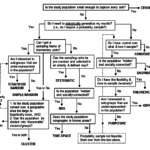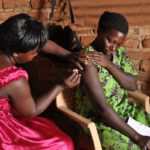As global health resources become more scarce and the prevalence of international crises increase, it is more important than ever that we design and target development programs to maximize our investments. The complexity of the applicable social, political and physical environments must be taken into consideration. Formative research can help us to understand these environments for program design, but formative research is often skipped due to budgetary, time or safety concerns that constrain the collection of new data. What many overlook is the vast untapped potential of existing household survey data that are rigorously collected, clean and freely available online around the world. By mining existing survey data, we can conduct the formative research necessary to maximize development impact.
Household survey data has come to replace vital registries in low and middle income countries (LMICs). Many LMICs are unable to invest in comprehensive, state-sponsored data collection programs that would provide information on key vital statistics and health indicators including fertility and mortality rates. This is largely due to financial constraints and insufficient capacity. There is a high demand for quality data, in particular to track progress toward human development goals, including the UN Millennium Development Goals and its post-2015 agenda: the Sustainable Development Goals. The implementation of household surveys has provided a solution to the data deficit.
External entities, like the World Bank or USAID, sponsor these surveys which are usually conducted every few years by local community outreach workers. There are thousands of household surveys conducted all over the world. However, the Demographic and Health Surveys (DHS), PMA 2020 and the World Bank’s Living Standards Measurement Survey (LSM) are largely the most recognized. These surveys collect high-quality data on demographics, health indicators, poverty, fertility and more. Much of these data are available for free online to researchers and program designers.
These publicly available datasets are particularly useful in fragile, unstable regions where new data collection can be costly and perilous. For example, many of the countries in the Sahel region of West Africa are stricken with the effects of climate change, terrorism and economic decline. Administering a survey to a representative sample may be impossible on a limited program budget. This is particularly true for formative research purposes as many funders do not require it. Instead of ignoring the need for formative research in regions that are too expensive to collect data from, household survey data can be utilized.
Using complex survey data analysis techniques, researchers can manipulate the data from such surveys to make country or regional level inferences about specific sub-populations. We can use this information in program design to target underlying causes within sub-populations and geographic regions most prone to fragility. This is critical in regions like the Sahel where data collection isn’t always feasible and good programs, based on formative research, are desperately needed.
Here is an example of how we used DHS data for three countries in the Sahel to inform the design of a large Marie Stopes International (MSI) contraceptive distribution program. As part of a broader effort to increase the access and adoption of contraceptives for women in the Sahel region, MSI implements programs to provide safe and affordable contraceptives to women. In order to deliver more long-acting contraceptives to young women (ages 15-24) in Burkina Faso, Mali and Niger, MSI is working to tailor their 2017 programming to the needs and preferences of young, sexually active women in these countries. Unable to collect new survey data for this formative research, MSI enlisted FHI 360 in 2016 to conduct research using the recent DHS surveys (from 1998 to 2012) in order to understand contraceptive use patterns and trends, and to identify indicators of long-acting contraceptive use for this group of women. We agreed that family planning services should acknowledge the societal norms and broader socio-cultural systems that affect the demand for contraceptives and attempted to capture them in our analysis.
Using exploratory regression analysis, the research team identified important drivers of contraceptive use that could best inform MSI’s programming in these areas. We were able to make inferences about contraceptive use patterns and trends for sexually-active, not pregnant women ages 15-24 in each country. The complex sampling methods these surveys employ allowed us to look specifically at the exact sub-population MSI hopes to impact.
Our findings led to unexpected conclusions. Modern contraceptive use was very low in all three countries ranging from 20% in Burkina Faso (2010) to 8% in Niger (2012). Use of long-acting or permanent methods was much lower, ranging from 2.4% in Burkina Faso (2010) to a mere 0.4% in Niger (2012). Traditionally, many programs focus on education and awareness about family planning assuming the constraint to use is lack of information. However, we found that knowledge of modern contraceptives was widely prevalent, with 85% of our targeted population reported knowing about modern contraceptive, even as high as 97% in Burkina Faso.
We also found that most of the young women in all three countries are married and starting to build families. Many reported a large ideal family size, with means for each country ranging from 5-9 children. Thus, it is understandable that young women are often not interested in using long-acting and permanent contraceptive methods (LAPM), even though they are aware of these options. These observations may explain the low demand for modern contraceptives in these countries. We concluded that family planning services may be more effective if they target programming on encouraging smaller family size, explaining the importance of birth spacing, and promoting women’s empowerment generally.
We were able to make these country level inferences for a specific sub-population without having to design surveys or conduct any data collection. This mining of the existing data provides an efficient way to increase the chances of program success by integrating data-driven program design and planning at the outset.
There are noteworthy limitations to using mined survey data for formative research. Researchers have no control over what questions were asked on the surveys and what kind of data was collected. Similarly, the timing of the surveys is out of our control. Most of these surveys are not administered annually, although with new mobile data collection tools that make data collection faster and cheaper, surveys are being conducted on a more regular basis. Finally, these surveys are not conducted in every country and are limited in very unstable regions where data collection is dangerous. Even with these limitations, we believe it is far better to use these data than ignore the need for formative research.
Rigorously collected, readily available data can vastly increase the ability of program designers and implementers to better inform their work. Mining these data is an efficient approach to formative research that informs the design of better, more effective programs that better serve vulnerable people in need and maximize development investment.
The authors are currently preparing a manuscript presenting the methods and full results of this research for journal submission.
Image credit: 2012 Akintunde Akinleye/NURHI, Courtesy of Photoshare




